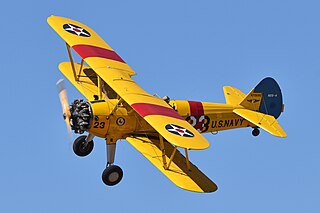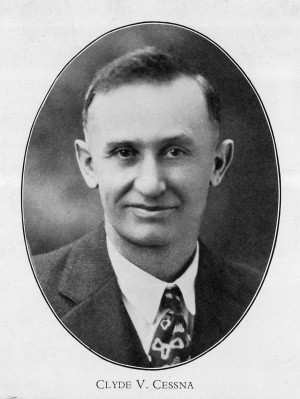Beechcraft is an American brand of civil aviation and military aircraft owned by Textron Aviation since 2014, headquartered in Wichita, Kansas. Originally, it was a brand of Beech Aircraft Corporation, an American manufacturer of general aviation, commercial, and military aircraft, ranging from light single-engined aircraft to twin-engined turboprop transports, business jets, and military trainers. Beech later became a division of Raytheon and then Hawker Beechcraft before a bankruptcy sale turned its assets over to Textron. It remains a brand of Textron Aviation.

Wichita is the most populous city in the U.S. state of Kansas and the county seat of Sedgwick County. As of the 2020 census, the population of the city was 397,532. The Wichita metro area had a population of 647,610 in 2020. It is located in south-central Kansas on the Arkansas River.

The Stearman (Boeing) Model 75 is an American biplane formerly used as a military trainer aircraft, of which at least 10,626 were built in the United States during the 1930s and 1940s. Stearman Aircraft became a subsidiary of Boeing in 1934. Widely known as the Stearman, Boeing Stearman, or Kaydet, it served as a primary trainer for the United States Army Air Forces, the United States Navy, and with the Royal Canadian Air Force as the Kaydet throughout World War II. After the conflict was over, thousands of surplus aircraft were sold on the civilian market. In the immediate postwar years, they became popular as crop dusters and sports planes, and for aerobatic and wing walking use in air shows.

The Travel Air Manufacturing Company was an aircraft manufacturer established in Wichita, Kansas, United States in January 1925 by Clyde Cessna, Walter Beech, and Lloyd Stearman.

Wichita Dwight D. Eisenhower National Airport is a commercial airport 7 miles (11 km) west of downtown Wichita, Kansas, United States. It is the largest and busiest airport in the state of Kansas. Located south of US-54 in southwest Wichita, it covers 3,248 acres and contains three runways.

Clyde Vernon Cessna was an American aircraft designer, aviator, and early aviation entrepreneur. He is best known as the principal founder of the Cessna Aircraft Corporation, which he started in 1927 in Wichita, Kansas.
Lloyd Carlton Stearman was an American aviator, aircraft designer, and early aviation entrepreneur.

College Park Airport is a public airport located in the City of College Park, in Prince George's County, Maryland, United States. It is the world's oldest continuously operated airport. The airport is located south of Paint Branch and Lake Artemesia, east of U.S. Route 1 and the College Park Metro/MARC station and west of Kenilworth Avenue.

Walter Herschel Beech was an American aviator and early aviation entrepreneur who co-founded the Beech Aircraft Company in 1932 with his wife, Olive Ann Beech, and a team of three others.

St. Louis Downtown Airport is a public-use airport located in Greater St. Louis, one mile (2 km) east of the central business district of Cahokia Heights, in St. Clair County, Illinois, United States. It is owned by the Bi-State Development Agency. The airport is located less than 3 miles from the Gateway Arch riverfront in St. Louis and is used by many business aircraft visiting the St. Louis region. Airport services include one full-service 24-hour fixed-base operator, an instrument landing system, an FAA air traffic control tower, and its own dedicated Index B aircraft rescue and firefighting (ARFF) service. It is utilized mainly by Saint Louis University's Parks College of Engineering, Aviation and Technology for training purposes, as well as the St. Louis Cardinals for charter flights to away games.

The Stearman 4 is an American commercial biplane that was manufactured in the 1920s by Stearman Aircraft. They were marketed at the time as fast and luxurious executive transports and mail planes for about US$16,000.

Fairfax Municipal Airport was a Kansas City, Kansas airfield from 1921 that was used during 1935–1949 by the military. Federal land adjacent to the airfield included a WWII B-25 Mitchell plant and modification center and a Military Air Transport terminal. After being used as a Cold War-era Air Force Base, it was used for airliner servicing by TWA and for automobile and jet fighter aircraft production by General Motors, which built a 1985 Fairfax Plant over runways when the municipal airport closed.
Riverside Airport was a privately owned, public use airport in Sedgwick County, Kansas, United States. It was located on the east side of the intersection of Hoover Rd. and 33rd Street North in northwest Wichita.
Westport Airport is a privately owned, public use airport located three nautical miles (6 km) southwest of the central business district of Wichita, a city in Sedgwick County, Kansas, United States. It is in the Class C airspace of neighboring Wichita Dwight D. Eisenhower National Airport.

The Honduran Aviation Museum,, is a museum foundation in Honduras, opened in September 2002 for the purpose of storing, preserving, restoring and exhibiting items related to Honduran aviation.
The history of Wichita details the history of Wichita, Kansas from its initial settlement in the 1860s to the present day.
Edward H. Phillips is an American writer/historian, aviation industry reporter, and aviator who has specialized in the general aviation industry of the central United States—with particular emphasis on the aviation history of Wichita, Kansas and its aircraft manufacturers.
Dwane Leon Wallace was an American aviation businessman and aircraft designer. He served as the president and/or chairman of the board of the Cessna Aircraft Company from 1935 until the 1970s, continuing then on the board as a director and consultant into the 1980s. Later known as the "Quiet Giant of Aviation", Wallace oversaw the company during a period of rapid and expansive growth within the general aviation industry, including development of the most-produced aircraft in history, the Cessna 172, as well as the popular Cessna Citation I business jet. He was posthumously inducted into the National Aviation Hall of Fame in 2012, and was included in Flying Magazine's list of the "51 Heroes of Aviation" in 2013, placing at number 11.

CAF Utah Wing Museum is one of many local detachments of the national Commemorative Air Force (CAF) non-profit aviation association dedicated to Honoring American Military Aviation through Flight, Exhibit and Remembrance.



















